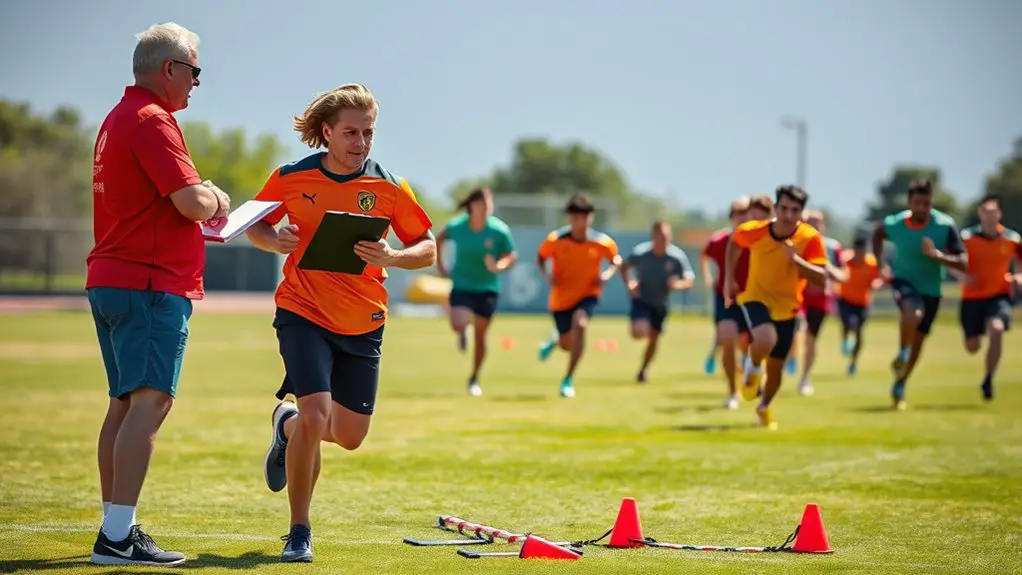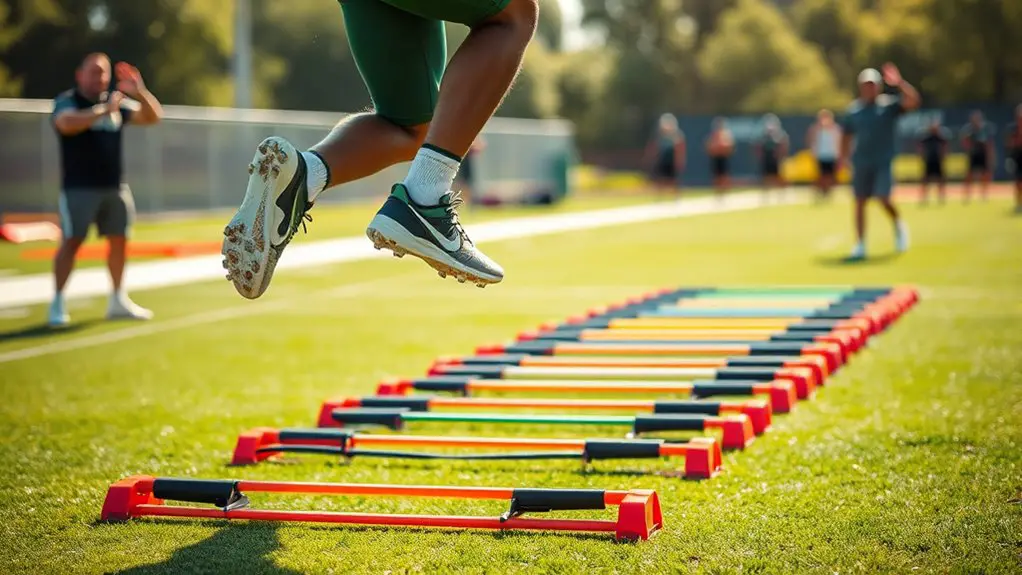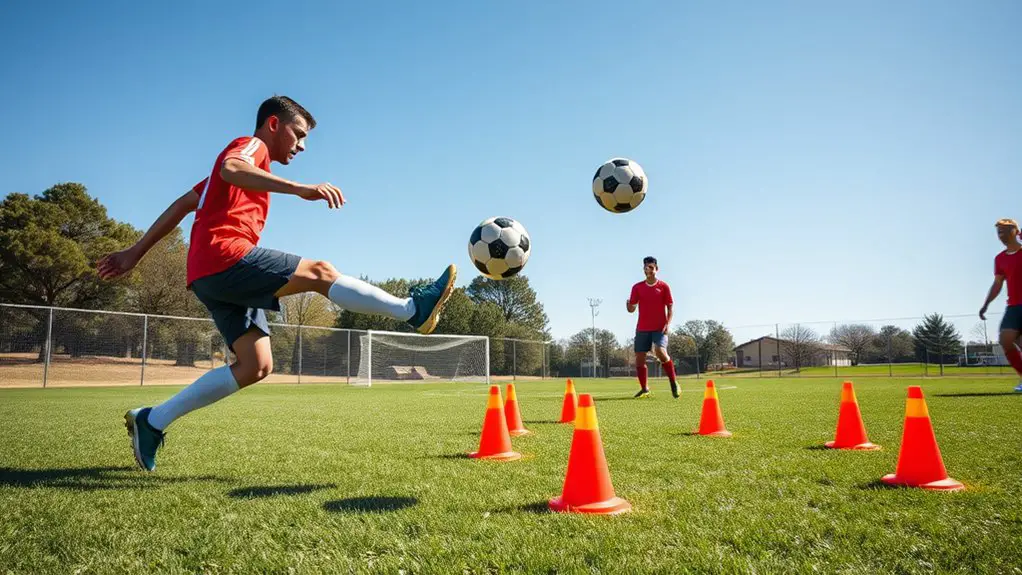To boost your performance on the football field, focus on sprint training techniques that enhance speed and agility. Proper starting positions, synchronized arm and leg movements, and dynamic stretching can improve your efficiency. Incorporate drills like hill sprints and resistance sprints for strength and explosive speed. Don't forget to combine strength training and flexibility exercises for ideal results. By following a well-rounded approach, you'll discover even more ways to elevate your game.
Understanding the Importance of Sprint Training in Football
When you consider the fast-paced nature of football, it's clear that sprint training plays an essential role in a player's performance. You need to understand that speed can make or break a game. Whether you're evading a tackle or chasing down the ball, explosive bursts of speed can give you the upper hand. Sprint training not only boosts your acceleration but also enhances your overall agility, allowing you to navigate the field more effectively.
Moreover, developing your sprinting ability builds your confidence. You'll feel empowered knowing you can outrun opponents, which can shift the momentum in your favor. It's not just about raw speed; it's about timing and precision in your movements. Incorporating sprint training into your routine can also improve your endurance, ensuring you maintain that speed throughout the match. Consistent warm-up routines, including dynamic stretching, can set the stage for better performance and injury prevention. So, embrace sprint training—it's your ticket to greater freedom on the field and an essential part of your football journey.
Key Sprinting Techniques for Football Players
To excel in sprinting, you need to focus on a few key techniques. Starting with the proper position and mastering your arm swing can greatly boost your acceleration. Let's break down these essential elements to help you maximize your performance on the field. Additionally, incorporating acceleration training into your regimen can further enhance your ability to reach top speeds quickly.
Proper Starting Position
A solid starting position can greatly impact your sprinting performance on the football field. To set yourself up for success, focus on these four key elements:
- Feet: Place one foot behind the other, ensuring the back foot is on the line, ready to explode off the ground.
- Knees: Bend your knees slightly, allowing for a powerful push-off without compromising balance.
- Back: Keep your back straight and lean slightly forward, creating a dynamic angle for acceleration.
- Hands: Position your hands just behind the starting line, fingers spread wide, ready to drive forward with your sprint.
Embrace this starting position, and you'll release your speed, giving you the freedom to dominate the game.
Arm Swing Mechanics
While many players focus on their leg movements, mastering arm swing mechanics is equally essential for maximizing sprinting efficiency on the football field. Your arms should move in sync with your legs, creating balance and rhythm. Keep your elbows bent at about 90 degrees, driving them back and forth to generate momentum. Avoid crossing your arms over your body; instead, let them move straight back and forth. This not only helps with speed but also maintains your posture. Remember, a strong arm swing can enhance your acceleration and overall sprint. So, practice these mechanics in your drills, and you'll feel the difference in your performance. Embrace the freedom that comes with powerful, coordinated movement!
Acceleration Techniques
Mastering acceleration techniques is essential for football players looking to gain an edge on the field. To release your speed, focus on these key elements:
- Start Position: Keep your weight forward, with your dominant foot slightly back, ready to explode off the line.
- Drive Phase: Push hard off the ground, using short, powerful strides to build momentum.
- Arm Action: Swing your arms vigorously in sync with your legs, driving them forward to enhance speed.
- Posture: Maintain an upright position as you accelerate, allowing for ideal airflow and balance.
Effective Sprint Drills to Enhance Acceleration
To enhance your acceleration on the field, incorporating effective sprint drills into your training routine can make a significant difference. Here are a few drills that can help you explode off the line and improve your speed.
| Drill | Description |
|---|---|
| Hill Sprints | Sprint up a hill to build strength and power. |
| Falling Starts | Begin in a standing position, fall forward, and sprint to focus on quick reaction. |
| A-Skip | Perform a skipping motion while driving your knees high, promoting form and rhythm. |
| Resistance Sprints | Use a sled or parachute to add resistance, enhancing power during acceleration. |
| Short Sprints | Sprint 10-20 yards at maximum effort to develop explosive speed. |
Incorporating these drills will not only improve your acceleration but also give you the freedom to dominate on the field. Remember, consistency is key! Additionally, focusing on running technique can help minimize energy wastage and further enhance your speed.
Building Top Speed: Advanced Sprinting Workouts
To reach your top speed, you'll want to incorporate advanced sprinting workouts into your training routine. Plyometric sprint drills, resistance sprint training, and speed endurance workouts can greatly boost your performance on the field. Incorporating technique work can further enhance your efficiency and effectiveness in sprinting. Let's explore how these techniques can help you maximize your sprinting potential.
Plyometric Sprint Drills
Plyometric sprint drills are essential for football players looking to enhance their top speed and explosive power. These drills push your limits, giving you that extra edge on the field. Here are four key exercises to incorporate into your training:
- Bounding: Leap forward using explosive power from your legs, aiming for distance and height.
- Box Jumps: Jump onto a sturdy platform, focusing on quick, explosive movements to build strength.
- Tuck Jumps: Propel yourself upward, tucking your knees towards your chest to improve power and agility.
- Depth Jumps: Step off a box and jump immediately upon landing, training your reactive strength.
Integrate these drills into your regimen, and you'll feel the freedom of speed as you fly past your opponents!
Resistance Sprint Training
After honing your explosive power with plyometric drills, it's time to take your speed training to the next level with resistance sprint training. This technique challenges your muscles and builds top-end speed by adding resistance, like sleds or harnesses. You'll engage your fast-twitch fibers more intensely, enhancing your sprinting efficiency.
Start with short distances; 20 to 40 yards is perfect. Focus on maintaining form while pushing against the resistance. As you grow stronger, gradually increase the load or distance. Remember, the goal is to train your body to explode past barriers, giving you that edge on the field. Embrace the challenge, and you'll find your freedom in speed, transforming your athletic performance in no time.
Speed Endurance Workouts
While resistance training builds explosive power, speed endurance workouts take your sprinting capabilities even further by focusing on maintaining high speeds over longer distances. These workouts help you push through fatigue, ensuring you can perform at your best when it matters most. Here's how to structure your speed endurance training:
- Long Sprints: Sprint for 150-300 meters at 90% effort, resting fully between.
- Fartlek Runs: Alternate between sprints and jogs to build stamina and speed.
- Interval Training: Perform 4-6 sets of 200 meters at max effort with short recovery.
- Pyramid Workouts: Gradually increase sprint distances (100m, 200m, 300m) and decrease rest time.
These techniques will enhance your freedom on the field, letting you dominate every play!
Incorporating Strength Training for Sprinting Performance
Incorporating strength training into your sprinting routine can considerably enhance your overall performance on the field. By building muscle strength, you'll generate more power during sprints, helping you explode off the line and maintain speed. Focus on compound movements like squats, deadlifts, and lunges; these exercises target major muscle groups and mimic the motions used in sprinting.
You don't need to spend hours in the gym—short, intense sessions can do wonders. Aim for 2-3 times a week, balancing strength training with your sprint workouts. Remember to include functional exercises that improve core stability, as a strong core contributes to better sprinting mechanics. Incorporating Olympic lifts into your routine can further enhance your explosive strength, crucial for sprinting success.
And don't forget to listen to your body; fatigue can lead to injuries. When you combine strength training with your sprinting regimen, you'll not only feel more powerful but also more confident as you take control of your game on the field.
The Role of Flexibility and Mobility in Sprinting
Strength training improves your sprinting power, but flexibility and mobility are just as important for maximizing performance. When you're agile and loose, you'll find that your strides become longer and more efficient, allowing you to fly down the field. Here's how flexibility and mobility play an essential role:
- Enhanced Range of Motion: Flexibility helps your muscles and joints move freely, reducing the risk of injury.
- Improved Stride Length: With better mobility, you can extend your legs further, boosting speed with every step.
- Faster Recovery: Flexible muscles recover quicker, keeping you in the game longer and enhancing your overall performance.
- Better Coordination: Increased mobility leads to smoother movements, allowing you to change direction swiftly when needed.
Incorporating dynamic stretches and mobility drills into your routine can set you free to release your full sprinting potential! Additionally, enhancing flexibility through targeted mobility training can further increase your athletic performance.
Monitoring Progress and Setting Goals for Sprint Training
To achieve your sprinting goals, it's crucial to monitor your progress and set specific targets. Start by recording your sprint times regularly; this'll help you see improvements over time. Consider using a variety of metrics, like distance, speed, and technique, to gauge your performance accurately.
Next, set SMART goals—Specific, Measurable, Achievable, Relevant, and Time-bound. Instead of saying, "I want to run faster," aim for, "I'll shave 0.2 seconds off my 40-yard dash in the next month." This clarity keeps you focused and motivated.
Don't forget to celebrate small victories along the way. Each milestone you hit reinforces your commitment to freedom in your training journey. Mix up your workouts to keep things exciting, and adjust your goals as you progress. That way, you'll stay engaged and continually work for improvement, pushing your limits and embracing the thrill of sprinting. Incorporating high-intensity interval training can also enhance your sprinting performance by improving your overall aerobic capacity.
Nutrition and Recovery: Supporting Your Sprint Training Efforts
While sprint training demands physical effort, nutrition and recovery play equally essential roles in your performance. To maximize your gains and maintain that sense of freedom on the field, focus on these key areas:
- Hydration: Drink plenty of water before, during, and after training to keep your muscles functioning efficiently. Proper hydration helps avoid fatigue and cramps that can sideline your performance.
- Balanced Meals: Fuel your body with a mix of proteins, healthy fats, and complex carbs to support muscle repair and energy levels.
- Post-Workout Snacks: Within 30 minutes of training, grab a quick snack like a protein shake or a banana to kickstart recovery.
- Quality Sleep: Aim for 7-9 hours of restful sleep each night; it's when your body repairs and builds muscle.
Frequently Asked Questions
How Often Should Football Players Sprint Train Each Week?
You should aim for sprint training two to three times a week. This frequency helps build speed and endurance without overtraining. Listen to your body, and adjust as needed to stay fresh and motivated.
What Are Common Injuries Associated With Sprint Training?
When it comes to sprint training, you might say, "No pain, no gain." However, common injuries like hamstring strains, calf pulls, and ankle sprains could hold you back, so always listen to your body and warm up properly.
Can Sprint Training Improve Endurance in Football?
Yes, sprint training can improve your endurance in football. It enhances your cardiovascular capacity and builds muscle efficiency, allowing you to maintain speed longer during games. You'll notice better performance and stamina on the field.
When Is the Best Time to Do Sprint Training?
The best time for sprint training is early in the day when you're fresh and focused. Alternatively, late afternoon can work too, as your body's warmed up. Just make sure you're consistent with it!
How Do Weather Conditions Affect Sprint Training Sessions?
Weather conditions can feel like a wild rollercoaster during sprint training. Rain or extreme heat can hinder your performance, but by adapting your sessions, you'll maintain that freedom to push your limits regardless of the elements.




